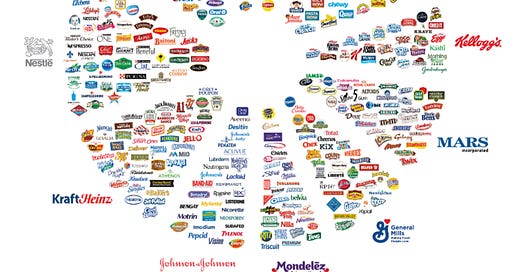🛒🍫 Consumer Packaged Goods (CPG) Industry Primer
1. Intro
2. Two Industry Wide Shifts
3. Key Players
4. Brand Recognition is Key to Success
5. Case Study: Proctor and Gamble
6. Risks
7. Outlook
Intro
The U.S. consumer packaged goods (CPG) market is a sizable sector that includes a variety of goods like food, drinks, personal care products, and household goods. It is marked by fierce rivalry, quickly shifting consumer preferences, and an increasing focus on sustainability and e-commerce. Companies like General Mills, Coca-Cola, and Procter & Gamble are significant players in the market. With an emphasis on internet marketing and direct-to-consumer sales, the market has seen developments toward healthier and more environmentally friendly products. It is essential to the U.S. economy, and it constantly changes in response to shifting consumer wants.
Two Industry Wide Shifts
The CPG space is unique in the fact that it is dealing with two industry wide shifts at the same time.
The shift to e-commerce in the retail universe has been accompanied by a notable emphasis on sustainability. As consumers increasingly opt for the convenience of online shopping, CPG companies are recognizing the environmental impact of increased packaging, transportation, and waste. This has prompted a reevaluation of packaging materials, with an emphasis on reducing single-use plastics and embracing more eco-friendly alternatives.
Additionally, CPG companies are making efforts to minimize their carbon footprint by optimizing logistics and transportation, and some are exploring local sourcing and production to reduce emissions. Sustainability has become a crucial factor in consumers’ purchasing decisions, compelling CPG companies to incorporate eco-conscious practices into their operations, from product design to delivery, as they navigate the digital landscape. Investors need to follow these trends and look into which companies are doing better than others as this unfolds.
Key Players
The largest and most influential CPG companies in the United States include:
Procter & Gamble PG 0.00%↑: Known for a wide range of consumer goods, including brands like Tide, Pampers, Gillette, and Pantene.
The Coca-Cola Company KO 0.00%↑ A global leader in the beverage industry with products like Coca-Cola, Diet Coke, and Sprite.
PepsiCo PEP 0.00%↑ Another major player in the beverage and snack industry, owning brands such as Pepsi, Tropicana, Gatorade, and Frito-Lay.
Nestlé ($NESN): A multinational corporation with a diverse portfolio, including brands like Nestlé, Purina, Gerber, and Nescafé.
General Mills GIS 0.00%↑: Specializing in food products, it produces well-known brands like Cheerios, Betty Crocker, and Häagen-Dazs.
Johnson & Johnson JNJ 0.00%↑: A diversified CPG company with a focus on healthcare and pharmaceuticals, offering products like Band-Aid, Neutrogena, and Listerine.
Kraft Heinz Company KHC 0.00%↑: A major player in the food industry, known for brands such as Kraft, Heinz, Oscar Mayer, and Kool-Aid.
Consumers often find their choices limited when shopping for consumer goods as a result of CPG companies owning a vast array of brands in the aisles. This concentration of ownership can create the appearance of diversity while, in reality, only a handful of major corporations dominate the market. These conglomerates leverage their resources and distribution networks, making it challenging for smaller, independent brands to compete. As a result, consumers may encounter a limited variety of options in stores, and it can be difficult to find products that truly stand out from the corporate giants' offerings.
This consolidation underscores the importance of supporting and promoting smaller, niche brands that can bring innovation and diversity to the CPG landscape while addressing consumer demands for unique and sustainable products. These challenges are further exacerbated by economic hardship or unique factors such as Covid, which magnifies the impact of economies of scale and makes it even more difficult for small companies to compete.
Brand Recognition is Key to Success
Keep reading with a 7-day free trial
Subscribe to Hump 🐪 Days to keep reading this post and get 7 days of free access to the full post archives.





